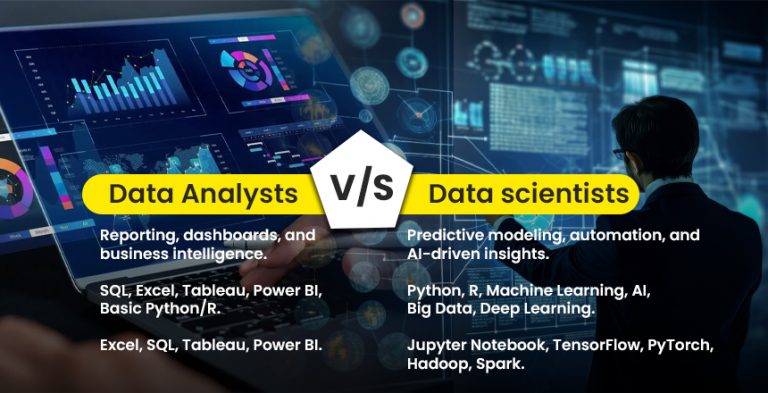With our lives guided by data from Netflix to the bank, it is data analysts who sort it out in the background. If at some point, you looked at a spreadsheet and saw possibilities for interesting stories or if you are intrigued by finding patterns and solving problems, a career in data analysis might be what you’re looking for.
What is the proper way to start? Is having a fancy degree required by the job? What technology should you understand? And how many years is it over? We’ve got everything under control for you.
Here is a simple and understandable guide to help you start working as a data analyst in 2025.
Step 1: Learn What a Data Analyst Really Does
Before you begin, it’s important to recognize what the role demands.
A data analyst organizes, cleans and explains data so that organizations can make smarter choices. Some of the things you may focus on are:
Studying how customers act
- Determining how successful your marketing campaigns are
- Looking for ways to make business processes more effective
- Noticing current patterns and making predictions for the future
- Most of your day will involve using spreadsheets, databases, VizX and charts—but you will also explain your findings to those who aren’t experts in data processing.
Step 2: Gain Competency in Important Skills
Here is what you should learn to succeed in data analyst:
1. Excel and Spreadsheets
It’s remarkable how often analysis is performed in Excel or Google Sheets. Get to know pivot tables, VLOOKUP, basic conditional formatting and how to create simple data visuals.
2. SQL stands for Structured Query Language.
SQL is the language we use to communicate with databases. You’ll often see that nearly every data analyst job requires some experience with SQL.
3. Software designed for visual data analysis
- Use tutorials to help you choose tools that are right for you.
- Tableau supports dashboard creation and can be used to share insights (or stories).
- Power BI works notably well in roles focused on business management.
- For easy visual displays, use both Excel charts and Google Data Studio.
4. Statistics & How to Use Data
Everywhere you go, you’ll need basic knowledge of stats. Be able to find average, variance, correlation, as well as to interpret p-values, confidence intervals and the concept of regression.
5. You can also use Python or R even though it’s not required.
If you’re looking to deep clean and automate your data, Python (using pandas, matplotlib and seaborn) or R will be very helpful.
To start, try Python because it is simpler to use and is used a lot in business.
Step 3: Try an online course or bootcamp.
You don’t necessarily have to study computer science to work as a data analyst. If you want to start with nothing, excellent online programs are available.
Popular websites that offer these services are:
- The Google Data Analytics Certificate (on Coursera)
- Data Analyst Professional Certificate from IBM
- You can learn on DataCamp, Udacity or freeCodeCamp.
- Quick and intensive career-focused training can be found at Springboard, General Assembly or Le Wagon.
Step 4: Begin working on actual projects.
It helps to learn about the tools, but you should really focus on putting them to use.
Easy projects for you to start with:
- Search a Netflix viewing dataset to discover what genres are the most popular.
- Check Google Trends to see how public interest shifted over the years
- Check the stats for COVID-19, keep up with sports scores or review YouTube comment threads
- Gather and organize your monthly expenses and finances in a dashboard
- Datasets for free use are available on Kaggle, Data.world and the UCI Machine Learning Repository.
Step 6: Construct a Portfolio
Your portfolio shows what you can do. It ought to consist of:
- Finish 2 to 3 full projects providing context, detailing how you cleaned the data, illustrating the visuals and sharing what conclusions you came to.
- Examples of tools used include Excel, SQL, Tableau and Python.
- Access to dashboards, GitHub projects or a personal website
- If you can, write a brief article about every project on LinkedIn or your own blog. Analyzers need strong communication skills and it shows this ability.
Step 6: Prepare for Finding a Job
After you’ve built your skills and created a portfolio, start applying for work.
Write your resume so that key skills and experience are noticeable.
- Microsoft Excel, SQL, Tableau and Python
- Ability to report and present (communicating)
- Whatever your niche is, learning about marketing, sales and finance is essential.
Try answering these types of interview questions:
- How can you clean up a dataset when it’s very messy?
- How do you manage the problem of missing or duplicate data?
Tell me about when you took data and used it to make a decision for your business.
Consider starting out by searching for lesser experienced positions.
- Data Analyst
- Business Analyst
- Junior Analyst
- Reporting Analyst
You can grow in your career by transitioning from operations or marketing analytics roles too.
Continue to Upgrade
There is no such thing as a short or final experience in data analysis. You will always face different problems and tools in your work.
Continue learning:
- Joins, subqueries and window functions are included in advanced SQL.
- NumPy and scikit-learn are two of the main Python libraries.
- Predictive analytics and machine learning are being used by companies in many ways.
- AI tools for different industries, for example, CRM analytics, A/B testing and saving data on Google BigQuery or Snowflake.
Final Thought
You don’t need a prior education to become a data analyst—it is entirely achievable. You just need a bit of tech knowledge, an interest in computers and plenty of practice. Trying to learn it all together will hold you back. Make sure to work through each step at a time.
Spending 6–12 months consistently on learning can help you qualify for real data positions. With organizations of all kinds using data insight, this demand is likely to continue for the long term.








